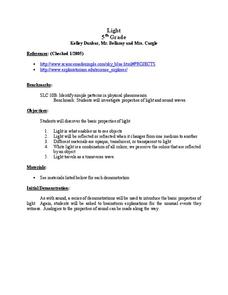Curated OER
Now You See Me, Now You Don't
Bioluminescence fascinates most upper elementary scientists. Display images of different glowing deep-sea organisms and discuss their environment. Young biologists then experiment with images and different colors of filtered light. In...
International Technology Education Association
Singin' the Black and Blues
How does the color of the sky change from blue to reds and oranges to black? An illuminating lesson explains how light travels through different mediums using the sun's light as an example. By examining diagrams and illustrations, pupils...
Curated OER
Light and Color
Students will see how different colors of lights mix. In this light and color lesson, students watch as flashlights of different colors are shined individually, then together. Students observe that the light travels in straight lines and...
Curated OER
Blinded by the Light
High schoolers recognize that the colors they see are a result of the reflection of light. For this light and color lesson, students predict what color will be produced when lights are mixed. They identify the three primary colors and...
Curated OER
Color Mixing
Students distinguish and recognize the three primary colors used in color printing. In this color mixing lesson, students predict what color will be produced when pigments or color beams are mixed. Students will demonstrate an...
Curated OER
Properties of Light
In this light waves worksheet, students will measure the wavelength of different light waves and then calculate its frequency. This worksheet has 9 short answer questions and 10 fill in the blank questions.
Curated OER
The Color of Light
Students explore the components of light as a combination of several colors. The focus of the lesson reveals that objects are viewed in a certain color because that color is reflected off of the object.
Curated OER
What Color is It?
Learners indentify whether an objects reflects or absorbs red, green, and/or blue light. They create a simple spectral signature.
Exploratorium
Bone Stress
Lighten up a bit with this activity! Use an old-fashioned overhead projector to shine light through a pair of polarizing filters. Place a stressed plastic object in between and display the colors of light waves revealed! Rotate the...
Curated OER
Energy: Light -- Spinning Color Wheel
Second graders make spinning color wheels to determine how energy effects what colors look like. They paint or color a color wheel with the seven colors of the spectrum. Next, the spin the wheel to determine what happens. In order to...
Curated OER
What You See Is What You Get
Learners explore light and colors. They see how white light is made up of various colors. They need to have some background knowledge about prisms, light wave lengths, and behavior of light, primary and secondary colors, and ratios.
Curated OER
Colors of Stars
Students observe the colors found in the flame of a burning candle and examine the basic concepts of matter and energy. Students apply this information to the color's of starts and the temperature of the stars photosphere. Students...
Curated OER
Colorful Colorado
Students investigate the components of white light as viewed through a prism. The multiple colors of the spectrum produced are related to wavelengths and experienced through the creation of a color wheel.
Curated OER
Light
Fifth graders sit in their seats with the lights on and then the teacher turns off the lights. After their eyes have adjusted, they vote on what colors of construction paper are being held up. The lights are then turned back on and...
Curated OER
Textured Animals - Stuffed Animal Still Life
After posing their stuffed animals your young artists will sketch them in light colored chalk. After sketching, the second graders fill the animal with lines to show the fur, or texture of the animal. They put a shadow under their...
Curated OER
How Do The Colors of Light Mix?
Students investigate the mixing of light. They form a hypotheses to reason why color changes occur and they write conclusions and ask new questions arising from the investigation. Students identify the primary and complementary colors of...
Curated OER
Colors, Computers, and Math Student Worksheet 1
In this color worksheet, students answer questions involving the visible spectrum. These eleven short answer questions involve wavelength, lux, and the effects of color on mood.
Curated OER
The Magic School Bus Makes a Rainbow
Students learn along with Ms. Frizzle's class. In this Magic School Bus lesson plan, students spin separate colors into a new color just as the Magic School Bus kids did.
Curated OER
Colors and The Great Gatsby: Fun Trivia Quiz
What is the symbolic importance of certain colors? This online, interactive quiz on The Great Gatsby asks questions related to colors and their symbolism; however, it requires little analysis. For the most part, test-takers match colors...
Urbana School District
Optics
Don't worry, optics is a light topic! The presentation covers reflection, refraction, fiber optics, mirages, prisms, rainbows, dispersion, mirrors, lenses, telescopes, diffraction, the human eye, and much, much more. Presentation is...
Curated OER
The Science of Color and Light
Students listen to a story about colors and then conduct various experiments to determine how people see colors, identify which colors stand out best from a distance, show the results of mixed colored lighting and explain the phenomenon...
Curated OER
Diversity: Using Light to Filter Prejudices
Learners use physics to discuss diversity. In this social interaction lesson, students use their knowledge of colors and filters to relate it to stereotyping and prejudices.
Curated OER
Color of Stars
Students study the color of stars. In this astronomy based lesson, students observe the colors in an open flame and apply the information collected about color and temperature to the visible light emitting from the photosphere of various...
Curated OER
HW Unit10:8- Color
In this color activity, high schoolers answer 16 questions about light, color and wavelength. They label a graph of position vs. displacement and answer questions about the graph including finding the frequency, amplitude, and wavelength.























